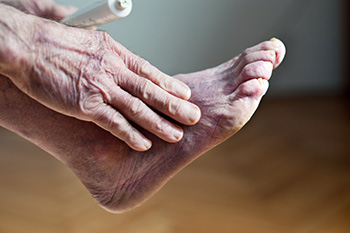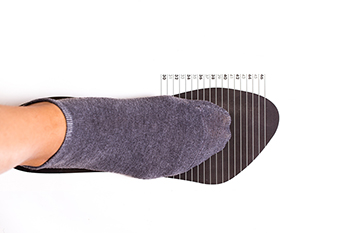Connect With Us
Blog
Items filtered by date: April 2024
Causes of Poor Foot Circulation and Finding Relief

Poor foot circulation, often referred to as peripheral artery disease, or PAD, can stem from various factors, affecting the flow of blood to the lower extremities. One common cause is atherosclerosis, where arteries become narrowed and hardened due to the buildup of plaque, restricting blood flow. Other contributing factors include diabetes, obesity, smoking, high cholesterol, and sedentary lifestyle habits. Symptoms of poor foot circulation include cold feet, numbness or tingling, cramping, or slow-healing wounds. To alleviate symptoms and improve circulation, lifestyle modifications play a critical role. Engaging in regular exercise, maintaining a healthy weight, quitting smoking, and managing underlying conditions like diabetes and high blood pressure are essential. Additionally, practicing proper foot care, including daily washing, moisturizing, and wearing comfortable, supportive footwear, can promote blood flow and reduce discomfort. For severe cases, medical interventions, such as medications or surgical procedures, may be necessary. If you are suffering from poor foot circulation, it is strongly suggested that you are under the care of a podiatrist who can help you to manage this condition.
Poor circulation is a serious condition and needs immediate medical attention. If you have any concerns with poor circulation in your feet contact Robert Hutchison, DPM, FACFAS of Lower Keys Foot & Ankle Surgery. Our doctor will treat your foot and ankle needs.
Poor Circulation in the Feet
Poor blood circulation in the feet and legs is can be caused by peripheral artery disease (PAD), which is the result of a buildup of plaque in the arteries.
Plaque buildup or atherosclerosis results from excess calcium and cholesterol in the bloodstream. This can restrict the amount of blood which can flow through the arteries. Poor blood circulation in the feet and legs are sometimes caused by inflammation in the blood vessels, known as vasculitis.
Causes
Lack of oxygen and oxygen from poor blood circulation restricts muscle growth and development. It can also cause:
- Muscle pain, stiffness, or weakness
- Numbness or cramping in the legs
- Skin discoloration
- Slower nail & hair growth
- Erectile dysfunction
Those who have diabetes or smoke are at greatest risk for poor circulation, as are those who are over 50. If you have poor circulation in the feet and legs it may be caused by PAD and is important to make changes to your lifestyle in order to reduce risk of getting a heart attack or stroke. Exercise and maintaining a healthy lifestyle will dramatically improve conditions.
As always, see a podiatrist as he or she will assist in finding a regimen that suits you. A podiatrist can also prescribe you any needed medication.
If you have any questions please feel free to contact our office located in Key West, FL . We offer the newest diagnostic and treatment technologies for all your foot and ankle needs.
What Can Cause a Broken Ankle?

A broken ankle can be a painful and debilitating injury, impacting mobility and daily activities. Understanding its causes and symptoms is vital for prompt diagnosis and appropriate treatment. An ankle fracture commonly occurs due to a sudden twisting or rolling motion of the ankle, often during activities like sports or falls. The severity of the fracture can vary, ranging from a hairline crack to a complete break of the bone. Symptoms typically include intense pain, swelling, bruising, and difficulty bearing weight on the affected ankle. In some cases, there may be visible deformity or an audible snap or pop at the time of injury. Additionally, individuals may experience numbness or tingling in the foot or ankle area. Seeking medical attention promptly is vital to assess the extent of the injury and prevent complications. There are various treatment methods for a broken ankle. If you have endured this type of injury, it is suggested that you consult a podiatrist who can determine what the best relief and treatment plan is for you.
Broken ankles need immediate treatment. If you are seeking treatment, contact Robert Hutchison, DPM, FACFAS from Lower Keys Foot & Ankle Surgery. Our doctor can provide the care you need to keep you pain-free and on your feet.
Broken Ankles
A broken ankle is experienced when a person fractures their tibia or fibula in the lower leg and ankle area. Both of these bones are attached at the bottom of the leg and combine to form what we know to be our ankle.
When a physician is referring to a break of the ankle, he or she is usually referring to a break in the area where the tibia and fibula are joined to create our ankle joint. Ankles are more prone to fractures because the ankle is an area that suffers a lot of pressure and stress. There are some obvious signs when a person experiences a fractured ankle, and the following symptoms may be present.
Symptoms of a Fractured Ankle
- Excessive pain when the area is touched or when any pressure is placed on the ankle
- Swelling around the area
- Bruising of the area
- Area appears to be deformed
If you suspect an ankle fracture, it is recommended to seek treatment as soon as possible. The sooner you have your podiatrist diagnose the fracture, the quicker you’ll be on the way towards recovery.
If you have any questions, please feel free to contact our office located in Key West, FL . We offer the newest diagnostic and treatment technologies for all your foot care needs.
A Guide to Measuring Shoe Size at Home

Measuring shoe size accurately at home ensures a comfortable and well-fitting footwear choice. Begin by gathering a piece of paper, a pen or pencil, a ruler or tape measure, and the pair of socks you intend to wear with the shoes. Place the paper flat on the floor against a wall and stand on it with your heel against the wall. With the pen or pencil held perpendicular to the paper, trace the outline of your foot. Use the ruler or tape measure to measure the longest distance from the heel to the tip of your longest toe. Repeat this process for the other foot as sizes may differ slightly. Compare the measurements to a shoe size chart available online or from shoe retailers to determine your correct size. Foot size may change over time, so it is advisable to measure periodically, especially before making new shoe purchases. If you have developed foot conditions from wearing shoes that do not fit well, it is suggested that you schedule an appointment with a podiatrist who can offer you treatment options, in addition to providing additional information about how to obtain the right shoe size.
Finding a properly-fitting shoe is important in reducing injuries and preventing foot problems. For more information about treatment, contact Robert Hutchison, DPM, FACFAS from Lower Keys Foot & Ankle Surgery. Our doctor will treat your foot and ankle needs.
Proper Shoe Fitting
A common concern when it comes to foot health, having properly fitted shoes can help prevent injuries to the foot. Out feet affect our posture and gait, which in turn affects the biomechanics and overall bodily structure. With 33 joints, 26 bones, and over 100 ligaments, the potential for serious injury is much greater than one realizes. Although the feet cease growth in adulthood, they still change shape as they mature. Here are some factors to consider when it comes to investing in proper fitting shoes:
- Be sure the shoes fit correctly right away
- Ensure the ball of your foot fits comfortably in the widest portion of the shoes
- Even though they may look fashionable, improper fitting shoes can either create adverse conditions or exacerbate existing ones you may already have
- Walk along a carpeted surface to ensure the shoes comfortably fit during normal activity
Keeping in mind how shoes fit the biomechanics of your body, properly-fitting shoes are vitally important. Fortunately, it is not difficult to acquire footwear that fits correctly. Be sure to wear shoes that support the overall structure of your body. Do your feet a favor and invest in several pairs of well-fitted shoes today.
If you have any questions please feel free to contact our office located in Key West, FL . We offer the newest diagnostic and treatment technologies for all your foot and ankle needs.
Ankle Fracture? Don’t Wait for Treatment
Causes of Foot Blisters

Foot blisters are often uncomfortable, and arise from various factors that warrant attention for prevention and management. Friction is a primary reason, occurring when repeated rubbing or pressure against the skin creates a separation between the layers of the skin, leading to fluid accumulation and blister formation. Wearing ill-fitting footwear, particularly shoes that are too tight or loose, can cause friction and increase the risk of blisters. Additionally, excessive moisture, such as sweat or wet conditions, softens the skin, making it more susceptible to friction-induced blisters. Activities that involve repetitive movements, like running or hiking, further heighten the likelihood of developing blisters. Moreover, certain foot deformities or abnormalities, such as bunions or hammertoes, may predispose individuals to blister formation due to altered pressure distribution. If you have developed foot blisters, it is suggested that you confer with a podiatrist who can offer effective treatment and prevention techniques.
Blisters are prone to making everyday activities extremely uncomfortable. If your feet are hurting, contact Robert Hutchison, DPM, FACFAS of Lower Keys Foot & Ankle Surgery. Our doctor can provide the care you need to keep you pain-free and on your feet.
Foot Blisters
Foot blisters develop as a result of constantly wearing tight or ill-fitting footwear. This happens due to the constant rubbing from the shoe, which can often lead to pain.
What Are Foot Blisters?
A foot blister is a small fluid-filled pocket that forms on the upper-most layer of the skin. Blisters are filled with clear fluid and can lead to blood drainage or pus if the area becomes infected.
How Do Blisters Form?
Blisters on the feet are often the result of constant friction of skin and material, usually by shoe rubbing. Walking in sandals, boots, or shoes that don’t fit properly for long periods of time can result in a blister. Having consistent foot moisture and humidity can easily lead to blister formation.
Prevention & Treatment
It is important to properly care for the affected area in order to prevent infection and ease the pain. Do not lance the blister and use a Band-Aid to provide pain relief. Also, be sure to keep your feet dry and wear proper fitting shoes. If you see blood or pus in a blister, seek assistance from a podiatrist.
If you have any questions, please feel free to contact our office located in Key West, FL . We offer the newest diagnostic and treatment technologies for all your foot care needs.

